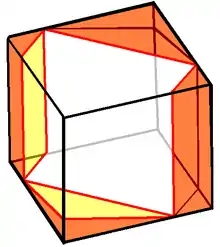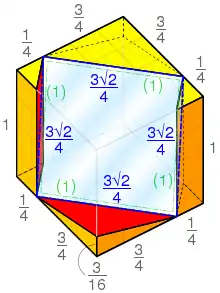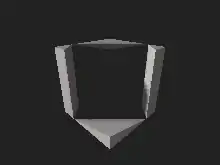Prince Rupert's cube
In geometry, Prince Rupert's cube (named after Prince Rupert of the Rhine) is the largest cube that can pass through a hole cut through a unit cube, i.e. through a cube whose sides have length 1, without splitting the cube into two pieces. Its side length is approximately 6% larger than that of the unit cube through which it passes. The problem of finding the largest square that lies entirely within a unit cube is closely related, and has the same solution.[1][2][3]

The original proposition posed by Prince Rupert of the Rhine was that a cube could be passed through a hole made in another cube of the same size without splitting the cube into two pieces.[4]
Solution

If two points are placed on two adjacent edges of a unit cube, each at a distance of 3/4 from the point where the two edges meet, then the distance between the two points will be
These two points, together with a second set of two points placed symmetrically on the opposite face of the cube, form the four vertices of a square that lies entirely within the unit cube. This square, extruded in both directions perpendicularly to itself, forms the hole through which a cube larger than the original one (up to side length ) may pass.[3]
The parts of the unit cube that remain, after emptying this hole, form two triangular prisms and two irregular tetrahedra, connected by thin bridges at the four vertices of the square. Each prism has as its six vertices two adjacent vertices of the cube, and four points along the edges of the cube at distance 1/4 from these cube vertices. Each tetrahedron has as its four vertices one vertex of the cube, two points at distance 3/4 from it on two of the adjacent edges, and one point at distance 3/16 from the cube vertex along the third adjacent edge.[5]

History
Prince Rupert's cube is named after Prince Rupert of the Rhine. According to a story recounted in 1693 by English mathematician John Wallis, Prince Rupert wagered that a hole could be cut through a cube, large enough to let another cube of the same size pass through it. Wallis showed that in fact such a hole was possible (with some errors that were not corrected until much later), and Prince Rupert won his wager.[1][2]
Wallis assumed that the hole would be parallel to a space diagonal of the cube. The projection of the cube onto a plane perpendicular to this diagonal is a regular hexagon, and the best hole parallel to the diagonal can be found by drawing the largest possible square that can be inscribed into this hexagon. Calculating the size of this square shows that a cube with side length
- ,
slightly larger than one, is capable of passing through the hole.[1]
Approximately 100 years later, Dutch mathematician Pieter Nieuwland found that a better solution (in fact, the optimal solution) may be achieved by using a hole with a different angle than the space diagonal. Nieuwland died in 1794 (a year after taking a position as a professor at the University of Leiden) but his solution was published posthumously in 1816 by Nieuwland's mentor, Jean Henri van Swinden.[1][2]
Since then, the problem has been repeated in many books on recreational mathematics, in some cases with Wallis' suboptimal solution instead of the optimal solution.[3][5][6][7][8][9][10][11][4]
Models

The construction of a physical model of Prince Rupert's cube is made challenging by the accuracy with which such a model needs to be measured, and the thinness of the connections between the remaining parts of the unit cube after the hole is cut through it. For the maximally sized-inner cube with length 1.06... relative to the length 1 outer cube, constructing a model has been called "mathematically possible but practically impossible".[12]
For the example using two cubes of the same size, as originally proposed by Prince Rupert, model construction is possible. In a 1950 survey of the problem, D. J. E. Schrek published photographs of a model of a cube passing through a hole in another cube.[13] Martin Raynsford has designed a template for constructing paper models of a cube with another cube passing through it; however, in order to account for the tolerances of paper construction and not tear the paper at the narrow joints between parts of the punctured cube, the hole in Raynsford's model only lets cubes through that are slightly smaller than the outer cube.[14]
Since the advent of 3D printing, construction of a Prince Rupert Cube of 1:1 ratio has become easy.[15]
Generalizations
A polyhedron P is said to have the Rupert property if a polyhedron of the same or larger size and the same shape as P can pass through a hole in P.[16] All five Platonic solids: the cube, the regular tetrahedron, regular octahedron,[17] regular dodecahedron, and regular icosahedron, have the Rupert property.[16] It has been conjectured[16] that all 3-dimensional convex polyhedra have this property. For n greater than 2, the n-dimensional hypercube also has the Rupert property.[18]
Of the 13 Archimedean solids, it is known that these nine have the Rupert property: the cuboctahedron, truncated octahedron, truncated cube, rhombicuboctahedron, icosidodecahedron, truncated cuboctahedron, truncated icosahedron, truncated dodecahedron.[19] and truncated tetrahedron.[20][21]
Another way to express the same problem is to ask for the largest square that lies within a unit cube. More generally, Jerrard & Wetzel (2004) show how to find the largest rectangle of a given aspect ratio that lies within a unit cube. As they show, the optimal rectangle must always pass through the center of the cube, with its vertices on edges of the cube. Based on this, they show, depending on the desired aspect ratio, that the optimal rectangle must either lie on a plane that cuts diagonally through four corners of the cube, or it must be formed by an isosceles right triangle on one corner of the cube and by the two opposite points, as in the case of Prince Rupert's problem.[2] If the aspect ratio is not constrained, the rectangle with the largest area that fits within a cube is the one that has two opposite edges of the cube as two of its sides, and two face diagonals as the other two sides.[22]
Alternatively, one may ask for the largest -dimensional hypercube that may be drawn within an -dimensional unit hypercube. The answer is always an algebraic number. For instance, the problem for asks for the largest cube within a four-dimensional hypercube. After Martin Gardner posed this question in Scientific American, Kay R. Pechenick DeVicci and several other readers showed that the answer for the (3,4) case is the square root of the smaller of two real roots of the polynomial , which works out to approximately 1.007435.[3][23] For , the optimal side length of the largest square in an -dimensional hypercube is either or , depending on whether is even or odd respectively.[24]
References
- Rickey, V. Frederick (2005), Dürer's Magic Square, Cardano's Rings, Prince Rupert's Cube, and Other Neat Things (PDF), archived from the original (PDF) on 2010-07-05. Notes for “Recreational Mathematics: A Short Course in Honor of the 300th Birthday of Benjamin Franklin,” Mathematical Association of America, Albuquerque, NM, August 2–3, 2005.
- Jerrard, Richard P.; Wetzel, John E. (2004), "Prince Rupert's rectangles", The American Mathematical Monthly, 111 (1): 22–31, doi:10.2307/4145012, JSTOR 4145012, MR 2026310.
- Gardner, Martin (2001), The Colossal Book of Mathematics: Classic Puzzles, Paradoxes, and Problems : Number Theory, Algebra, Geometry, Probability, Topology, Game Theory, Infinity, and Other Topics of Recreational Mathematics, W. W. Norton & Company, pp. 172–173, ISBN 9780393020236.
- Pickover, Clifford A. (2009), The Math Book: From Pythagoras to the 57th Dimension, 250 Milestones in the History of Mathematics, Sterling Publishing Company, Inc., p. 214, ISBN 9781402757969.
- Wells, David (1997), The Penguin Dictionary of Curious and Interesting Numbers (3rd ed.), Penguin, p. 16, ISBN 9780140261493.
- Ozanam, Jacques (1803), Montucla, Jean Étienne; Hutton, Charles (eds.), Recreations in Mathematics and Natural Philosophy: Containing Amusing Dissertations and Enquiries Concerning a Variety of Subjects the Most Remarkable and Proper to Excite Curiosity and Attention to the Whole Range of the Mathematical and Philosophical Sciences, G. Kearsley, pp. 315–316.
- Dudeney, Henry Ernest (1936), Modern puzzles and how to solve them, p. 149
- Ogilvy, C. Stanley (1956), Through the Mathescope, Oxford University Press, pp. 54–55. Reprinted as Ogilvy, C. Stanley (1994), Excursions in mathematics, New York: Dover Publications Inc., ISBN 0-486-28283-X, MR 1313725.
- Ehrenfeucht, Aniela (1964), The cube made interesting, New York: The Macmillan Co., p. 77, MR 0170242. Translated from the Polish by Waclaw Zawadowski.
- Stewart, Ian (2001), Flatterland: Like Flatland Only More So, Macmillan, pp. 49–50, ISBN 9780333783122.
- Darling, David (2004), The Universal Book of Mathematics: From Abracadabra to Zeno's Paradoxes, John Wiley & Sons, p. 255, ISBN 9780471667001.
- Sriraman, Bharath (2009), "Mathematics and literature (the sequel): imagination as a pathway to advanced mathematical ideas and philosophy", in Sriraman, Bharath; Freiman, Viktor; Lirette-Pitre, Nicole (eds.), Interdisciplinarity, Creativity, and Learning: Mathematics With Literature, Paradoxes, History, Technology, and Modeling, Montana Mathematics Enthusiast Monograph Series in Mathematics Education, 7, Information Age Publishing, Inc., pp. 41–54, ISBN 9781607521013.
- Schrek, D. J. E. (1950), "Prince Rupert's problem and its extension by Pieter Nieuwland", Scripta Mathematica, 16: 73–80 and 261–267. As cited by Rickey (2005) and Jerrard & Wetzel (2004).
- Hart, George W. (January 30, 2012), Math Monday: Passing a Cube Through Another Cube, Museum of Mathematics. Originally published in Make Online.
- 3geek14, Prince Rupert's Cube, Shapeways, retrieved 2017-02-06.
- Jerrard, Richard P.; Wetzel, John E.; Yuan, Liping (April 2017). "Platonic Passages". Mathematics Magazine. Washington, DC: Mathematical Association of America. 90 (2): 87–98. doi:10.4169/math.mag.90.2.87. S2CID 218542147.
- Scriba, Christoph J. (1968), "Das Problem des Prinzen Ruprecht von der Pfalz", Praxis der Mathematik (in German), 10 (9): 241–246, MR 0497615
- Huber, Greg; Shultz, Kay Pechenick; Wetzel, John E. (June–July 2018). "The n-Cube is Rupert". American Mathematical Monthly. Washington, DC: Mathematical Association of America. 125 (6): 505–512. doi:10.1080/00029890.2018.1448197. S2CID 51841349.
- Chai, Ying; Yuan, Liping; Zamfirescu, Tudor (June–July 2018). "Rupert Property of Archimedean Solids". American Mathematical Monthly. Washington, DC: Mathematical Association of America. 125 (6): 497–504. doi:10.1080/00029890.2018.1449505. S2CID 125508192.
- Hoffmann, Balazs (2019). "Rupert properties of polyhedra and the generalized Nieuwland constant". J. Geom. Graph. 23 (1): 29–35.
- Lavau, Gérard (December 2019). "The Truncated Tetrahedron is Rupert". American Mathematical Monthly. Washington, DC: Mathematical Association of America. 126 (10): 929–932. doi:10.1080/00029890.2019.1656958. S2CID 213502432.
- Thompson, Silvanus P.; Gardner, Martin (1998), Calculus Made Easy (3rd ed.), Macmillan, p. 315, ISBN 9780312185480.
- Guy, Richard K.; Nowakowski, Richard J. (1997), "Unsolved Problems: Monthly Unsolved Problems, 1969-1997", The American Mathematical Monthly, 104 (10): 967–973, doi:10.2307/2974481, JSTOR 2974481, MR 1543116.
- Weisstein, Eric W. "Cube Square Inscribing". MathWorld.